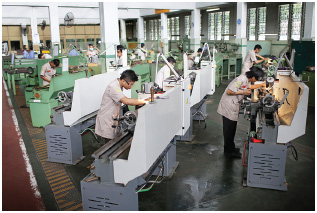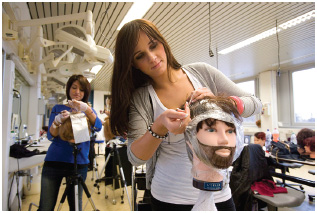What Is Vocational Technical Training?
Vocational technical training is an educational process in which students learn specific skills that will help them succeed in different careers or trades. This focus on specific skills and careers makes vocational technical training different from other academic programs, which often emphasize the study of general academic information and theory. Students typically receive vocational training in high school or postsecondary school and in specialized trade schools. Special programs also sometimes offer vocational education for different members of the community. By attending vocational programs, students can receive on-the-job training to determine their career interests and talents.

Vocational technical training is known by several other names, including voc-tech education, vocational education, voc-ed, vocational education and training (VET), career and technical education, trade teaching, trade school, and industrial training. This training relates to a large number of fields and thus can prepare students for careers in a wide variety of industries. Since vocational training courses focus on specific topics and skills, they might appeal to students who dislike the generalized approach often associated with other types of academic programs. The variety of vocational programs and their emphasis on career training make vocational training a viable option for people entering the workforce or seeking to make a career change.

Students working on lathes at the vocational training school ATMI, in Solo, Indonesia. THOMAS KOEHLER/PHOTOTHEK/GETTY IMAGES.
What Is the History of Vocational Technical Training Programs?
One could argue that vocational training has existed as long as there have been careers: experienced workers have long trained less-experienced workers in apprenticeships in many areas of the world. In the United States, other forms of vocational training began to develop in the nineteenth and early twentieth centuries. Beginning in the twentieth century, the U.S. federal government created laws that encouraged and funded vocational training for various populations, including wounded military veterans and disabled individuals. Later, vocational training came to encompass many different fields and serve a wide segment of the population.
Public school systems typically operate vocational programs. Some public high schools and community colleges offer vocational programs along with general academic courses. Some public school systems, especially those in more populous areas, have entire schools devoted to vocational education. High school students at these centers often perform “real world” work. This work can range from customizing vehicles for automobile shows to cooking food in restaurants operated by the centers.
In addition to public schools, specialized institutions offer students the opportunity to learn vocational technical skills. Students might learn these skills in classrooms, in job situations, while studying and working online, or in some combination of those options. Online vocational studies became more common in the twenty-first century. These online programs allow students and instructors the flexibility to learn and to teach while attending to other areas in their busy lives, such as work and family matters.
What Are Some Different Kinds of Vocational Technical Training Programs?
Students who have successfully completed vocational technical training might work in fields as diverse as computing, the automotive industries,
construction, medicine, cosmetology, food and hospitality services, or agriculture. Vocational training often offers multiple programs within each of those fields, creating an even wider variety of instructional opportunities. In medicine and wellness alone, for example, vocational training might lead to a career as a medical assistant, dental assistant, clinical nurse aide, dialysis technician, medical biller, pharmacy technician, or massage therapist, among several others.
In addition to the vocational programs offered at secondary, post-secondary, and trade schools, community groups and institutions such as prisons sometimes operate vocational programs. Prison administrators hope that teaching inmates skills will help them find jobs upon their release so they will be less likely to commit crimes and return to prison. Like other vocational programs, prison programs teach specific job-based skills to people looking for educational and career training during a transitional time in their lives.

Apprenticeship as hairdresser machines mechanic in the Butzweilerhof education center in Cologne, Germany. ULRICH BAUMGARTEN/GETTY IMAGES.
What Are the Parts of a Vocational Technical Training Program?
Vocational technical training programs consist of a variety of courses as well as other components. Many programs offer both classroom learning and hands-on experience through educational and work situations. Vocational programs for medical assistants, for instance, typically require students to take courses on such topics as medical issues and terminology, office administration, and ethics. The programs also require students to participate in work situations. Students fulfill their programs’ work requirements by serving in externships, programs that train students by allowing them to participate in real work environments related to their fields of study.
Students in dental-assistant vocational programs often get hands-on training while helping the community, providing dental services through clinics associated with vocational schools. Similarly, students in vocational cosmetology programs often offer inexpensive haircuts, manicures, and other beauty treatments at vocational school salons. Such arrangements allow students to learn their trades in a work setting.
Students who finish a vocational training program earn a certificate that verifies their successful completion of the program. The training also sometimes helps students pass tests that give them additional certification. These certifications often help graduates find their first jobs or jobs in new fields. Training for vocational certifications also helps students gain skills that can lead to promotions and pay raises in their current careers.
How Can I Find Vocational Technical Training Programs?
High schools and community colleges that offer vocational technical training often have general or career counselors to advise people about vocational programs. Some schools have areas devoted to vocational and career studies. Many local libraries also offer career centers or computing labs. The libraries allow people to study books, periodicals, online works, and other materials about vocational training and offer career preparation tools. You can also learn about vocational programs through other media. For example, vocational technical institutes often advertise their offerings on television, in periodicals, and online.
Given the popularity of online materials, it is not surprising that there are a number of online resources for people considering vocational training. Vocational schools have websites describing their facilities and course offerings. These websites might provide reviews of the school from current and former students. You can also search for such school reviews on independent review sites. By searching the Internet, you can look for newspaper and magazine articles that discuss specific vocational programs and recent developments in vocational education.
Prospective students can also study government websites to learn about careers and vocational training. One such work resource can be found on the state of Indiana's website Hoosiers by the Numbers. Created by Indiana's Department of Workforce Development, the Virtual Career Counselor includes economic data and tools for users who are considering a career change.